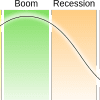Many mainstream economists want nothing to do with economic cycle theorists, but it should be noted that  economic cycle theories have enabled some analysts to correctly predict the timing of recessions, stock market peaks and stock market crashes over the past couple of decades – and there are many economists who believe that…the period from 2014 to 2020 is going to turn out to be pure hell for the United States.
economic cycle theories have enabled some analysts to correctly predict the timing of recessions, stock market peaks and stock market crashes over the past couple of decades – and there are many economists who believe that…the period from 2014 to 2020 is going to turn out to be pure hell for the United States.
The above are edited excerpts from an article* by Michael Snyder (theeconomiccollapseblog.com) entitled If Economic Cycle Theorists Are Correct, 2015 To 2020 Will Be Pure Hell For The United States.
The following article is presented by Lorimer Wilson, editor of www.munKNEE.com (Your Key to Making Money!) and the FREE Market Intelligence Report newsletter (sample here) and has been edited, abridged and/or reformatted (some sub-titles and bold/italics emphases) for the sake of clarity and brevity to ensure a fast and easy read. This paragraph must be included in any article re-posting to avoid copyright infringement.
Snyder goes on to say in further edited excerpts:
Nikolai Kondratiff Predicts:
“One of the most prominent economic cycle theories is known as “the Kondratieff wave” developed by a Russian economist named Nikolai Kondratiev whose economic theories got him into so much trouble with the Russian government that he was executed in 1938 because of them…
In recent years, there has been a resurgence of interest in the Kondratieff wave. The following is an excerpt from an article by Christopher Quigley that discussed how this theory works:
Kondratiev’s analysis described how international capitalism had gone through many such “great depressions” and as such were a normal part of the international mercantile credit system. The long term business cycles that he identified through meticulous research are now called “Kondratieff” cycles or “K” waves. The K wave is a 60 year cycle (+/- a year or so) with internal phases that are sometimes characterized as seasons: spring, summer, autumn and winter:
- Spring phase: a new factor of production, good economic times, rising inflation
- Summer: hubristic ‘peak’ war followed by societal doubts and double digit inflation
- Autumn: the financial fix of inflation leads to a credit boom which creates a false plateau of prosperity that ends in a speculative bubble
- Winter: excess capacity worked off by massive debt repudiation, commodity deflation & economic depression. A ‘trough’ war breaks psychology of doom.
Increasingly economic academia has come to realize the brilliant insight of Nikolai Kondratiev and accordingly there have been many reports, articles, theses and books written on the subject of this “cyclical” phenomenon…
What does the Kondratieff wave theory suggest is coming next for us?
Well, according to work done by Professor W. Thompson of Indiana University, we are heading into an economic depression that should last until about the year 2020…
If we accept the fact that most winters in K cycles last 20 years this would indicate that we are about halfway through the Kondratieff winter that commenced in the year 2000. Thus, in all probability, we will be moving from a “recession” to a “depression” phase in the cycle about the year 2013 and it should last until approximately 2017-2020.
Harry Dent Predicts:
The Kondratieff wave is far from the only economic cycle theory that indicates that we are heading for an economic depression. The economic cycle theories of author Harry Dent also predict that we are on the verge of massive economic problems. He mainly focuses on demographics, and the fact that our population is rapidly getting older is a major issue for him.
The following is an excerpt from a Business Insider article that summarizes the major points that Dent makes in his new book…
- Young people cause inflation because they “cost everything and produce nothing” but young people eventually “begin to pay off when they enter the workforce and become productive new workers (supply) and higher-spending consumers (demand).”
- Unfortunately, the U.S. reached its demographic “peak spending” from 2003-2007 and is headed for the “demographic cliff.” Germany, England, Switzerland are all headed there too. Then China will be the first emerging market to fall off the cliff, albeit in a few decades. The world is getting older.
- The U.S. stock market will crash. “Our best long-term and intermediate cycles suggest another slowdown and stock crash accelerating between very early 2014 and early 2015, and possibly lasting well into 2015 or even 2016. The worst economic trends due to demographics will hit between 2014 and 2019. The U.S. economy is likely to suffer a minor or major crash by early 2015 and another between late 2017 and late 2019 or early 2020 at the latest.”
- “The everyday consumer never came out of the last recession.” The rich are the ones feeling great and spending money, as asset prices (not wages) are aided by monetary stimulus.
- The U.S. and Europe are headed in the same direction as Japan, a country still in a “coma economy precisely because it never let its debt bubble de-leverage,” Dent argues. “The only way we will not follow in Japan’s footsteps is if the Federal Reserve stops printing new money.”
- “The reality is stark, when…[sellers] start to outweigh buyers, the market changes.” It all comes down to an aging population, Dent writes. “Fewer spenders, borrowers, and investors will be around to participate in the next boom.”
- The U.S. has a crazy amount of debt and “economists and politicians have acted like we can just wave a magic wand of endless monetary injections and bailouts and get over what they see as a short-term crisis” but the problem, Dent says, is long-term and structural — demographics.
- Businesses can “dominate the years to come” by focusing on cash and cash flow, being “lean and mean,” deferring major capital expenditures, selling nonstrategic real estate, and firing weak employees now.
- The big four challenges in the years ahead will be:
- 1) private and public debt
- 2) health care and retirement entitlements
- 3) authoritarian governance around the globe and
- 4) environmental pollution that threatens the global economy.
- Harry Dent Sees Dow 3,000
- Since Harry Dent is Calling for Catastrophe, Maybe It’s Time to Buy! Here’s Why
According to Dent, “the crisis will occur between 2014 and 2023, with the worst likely starting in 2014 and continuing, off and on, into late 2019.” …
…Of course there are many, many other economic cycle theories that seem to indicate that trouble is ahead for the United States as well. The following is a summary of some of them from an article by GE Christenson and Taki Tsaklanos…as posted on munKNEE.com.
Charles Nenner Research
Stocks should peak in mid-2013 and fall until about 2020. Similarly, bonds should peak in the summer of 2013 and fall thereafter for 20 years. He bases his conclusions entirely on cycle research. He expects the Dow to fall to around 5,000 by 2018 – 2020.
Kress Cycles (Clif Droke)
The major 120 year cycle plus all minor cycles trend down into late 2014. The stock market should decline hard into late 2014.
Elliott Wave (Robert Prechter)
The stock market has peaked and has entered a generational bear-market with a crash in the market around 2016 – 2017.
Market Energy Waves
A 36 year cycle in stock markets is peaking in mid-2013 and will cycle down for 2013 – 2016…[with] equity markets should drop 25 – 50%.
Armstrong Economics
A peak in confidence in August 2013, a bottom in September 2014, and another peak in October 2015…[with] a world-wide crash and contraction in economies from 2015 into January 2020.
Cycles per Charles Hugh Smith
Four long-term cycles – Credit expansion/contraction cycle, Price inflation/wage cycle, Generational cycle, and Peak oil extraction cycle – will bottom in the 2010 to 2020 period.
Conclusion
Does history repeat itself? Well, it should be disconcerting to a lot of people that 2014 is turning out to be eerily similar to 2007 but we never learned the lessons that we should have learned from the last major economic crisis, and most Americans are way too apathetic to notice that we are making many of the very same mistakes all over again. Just in the last few months, for example, there have been a whole host of indications that the next major economic downturn is just around the corner.
Let’s hope that all of the economic cycle theories discussed above are wrong this time, but we would be quite foolish to ignore their warnings. Everything indicates that a great economic storm is rapidly approaching, and we should use this time of relative calm to get prepared while we still can.
Editor’s Note: The author’s views and conclusions in the above article are unaltered and no personal comments have been included to maintain the integrity of the original post. Furthermore, the views, conclusions and any recommendations offered in this article are not to be construed as an endorsement of such by the editor.
*http://theeconomiccollapseblog.com/archives/if-economic-cycle-theorists-are-correct-2015-to-2020-will-be-pure-hell-for-the-united-states (Copyright © 2014 The Economic Collapse)
Related Articles:
1.These 20 Cycle Theories Suggest Stock Markets, Gold & Bonds To Severely Correct
Unsustainable trends can survive much longer than most people anticipate, but they do end when their “time is up” – at the culmination of their time cycles…In an effort to bring clarity in how and when these trends could change direction we analyzed more than 20 different cycles. They almost unanimously point to tectonic shifts in the months and years ahead … starting now. We have been warned. At this point, we have enough confirmation to accept that the gold and silver crash – starting in April of 2013 – was the first shot across the board of what is to come. Read on! Read More »
2. Charles Nenner: Dow to Peak in 2012 and Then Decline to 5,000!
Charles Nenner has been accurately predicting movements in the liquid markets for more than 25 years, and his most recent cycle analysis predicts that the current stock market rally is going to last through Q2 and then begin a major descent in 2013 – with the Dow eventually reaching 5,000! Read on to learn how Nenner’s unique system works and what he forecasts for commodities, currencies, bonds, interest rates and more. Words: 400 Read More »
3. Since Harry Dent is Calling for Catastrophe, Maybe It’s Time to Buy! Here’s Why
Now marketing himself as a “rogue economist,” Harry Dent is forecasting “gold down to $750 an ounce, housing down 35%, oil down to $10 a barrel, the Dow down to 6,000, [and] a war between inflation and deflation” this year. His swami-like predictions in the past have been truly dreadful but, unlike most of his ilk, Dent has perhaps offered something actionable, if not in the way he intended. Let me explain. Read More »
4. James Turk Interviews Robert Prechter: Which Will It Be – Hyperinflation or Massive Deflation?
James Turk believes hyperinflation is ahead. Bob Prechter believes massive deflation is coming. An interesting discussion between the two takes place in this audio. Ultimately, both lead to Depression. Only the route taken differs, but that is important. Read More »
5. Current Long Wave Kondratieff Winter Snow Storm to End in an Economic Avalanche – Here’s Why
There are several variations of Long Wave theory, but the most famous is based on the work of Nicolai Kondratieff, a Russian economist who gave the various stages seasonal names, with summer and autumn denoting the peak of financial speculation and winter the aftermath of the resulting crash. The conditions for a global catastrophic failure are in place. Snow (in the form of trillions of new dollars and euros) is falling. There’s no way to know which dollar (or which external event) will start the avalanche, but without doubt something will. [Let me expand on why I hold that view.] Words: 888 Read More »
6. Harry Dent Sees Dow 3,000; Seth Masters Sees Dow 20,000! Who’s Most Likely Right?
Harry Dent, the financial newsletter writer and CEO of economic forecasting firm HS Dent, has one of the most bearish calls on stocks we’ve heard in a while. Appearing on CNBC yesterday, Dent explained the demographics-driven thesis behind his Dow 3000 call. Read More »
7. Dent: How to Prepare and Prosper from “The Great Depression Ahead”
Most investors didn’t take warnings about the future of the economy and the financial marketplace – warnings that a ‘Category 6 Fiscal Storm’, a ‘Debt-Driven Meltdown’, a ‘Systemic Banking Crisis’, a ‘Financial Train Wreck’, a ‘God-Awful Fiscal Storm’, etc. was in store for the U.S. – seriously until it began. Perhaps this time around, before the other shoe drops, we should become more informed so we will be better positioned to survive and prosper regardless of what comes next. Words: 2128 Read More »
8. Martin Armstrong: The Next Wave Begins June 13th, 2011
We are approaching the end of the current 8.6 year wave come June 13th, 2011. What awaits us on the other side is a change in the overall trend. [Let me explain what is developing.] Words: 420 Read More »
 munKNEE.com Your Key to Making Money
munKNEE.com Your Key to Making Money



I believe that the USA will experience more than one decline in the value of the US$ that viewed together will form one “evolving” devaluation for one or more of these reasons:
A. Failed attempts to deal satisfactory with other countries who start to use other currency instead of the US$ to trade internationally.
B. People running out of savings and/or 401 funds which they have been using to supplement their current spending, which will have a negative effect on the economy.
C. Another wave of mortgage defaults will occur as yet more Americans lose their jobs as the economy retracts, since ever less people will be able to afford to qualify for a loan.
D. More people will start to invest in PM’s as they see their paper money’s value start to decline, as they realize that the Fed is only trying to protect itself and not the value of the US$.
E. Rising frustration with failed Leadership in both parties will result in stagnation of the US economy, unless one Party wins a majority in both Congress and the Senate and ends Congressional gridlock.
G. Ever more Seniors will retire “overseas” taking all their money with them, which will result in yet another reduction in domestic spending that our struggling economy can ill afford.